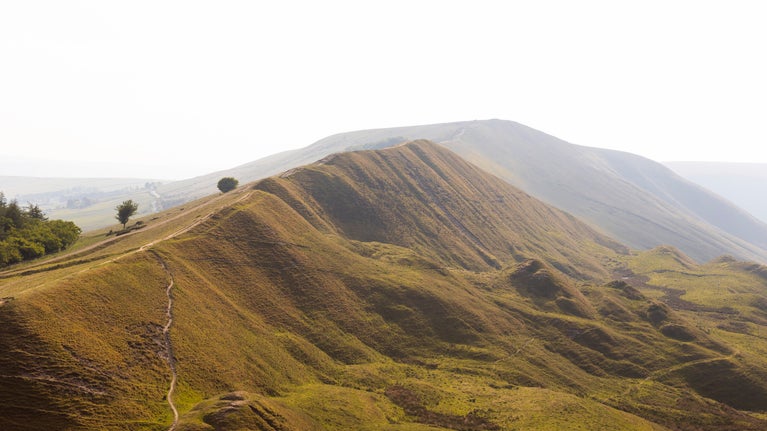
Archaeological work
We look after many rich and diverse archaeological sites. Archaeology helps us to learn more about them and protect them for the future.

Many Iron Age hillforts in our care were built more than 2,000 years ago. Today they are special wild places where different plant, bird, animal, and insect species thrive. Discover more about the ancient landmarks where our ancestors lived and defended themselves, and learn how hillfort management is helping protect both nature and archaeology.
The Iron Age hillfort is one of the most impressive earthworks of the UK landscape. It reflects the organisational and engineering skill, as well as the defensive mastery, of its maker. There are different theories as to why they were built. They may have been created as a defence against hostile neighbours, or as a status symbol for a local chief. But without doubt, their construction demanded a co-ordinated physical effort by many people.
Some hillforts have a single bank (termed rampart) and ditch and are known as univallate hillforts. Those with two or more banks and ditches are described as multivallate hillforts. The gateways to hillforts were the weakest part of the defence and were often defended by complicated earthworks. These were built to confuse and impress, forcing hostile warriors to weave between ramparts before reaching the gates.
Through archaeological research we’ve discovered more about the hillforts in our care. For example, inside the inner ramparts at Figsbury Ring in Wiltshire there are circular hollows terraced into the hill slope. These are thought to be the remains of Iron Age roundhouses.
Aerial photography around some areas, such as Park Hill Camp in Wiltshire show traces of field systems and farmsteads, revealing how much of the land was cultivated 2,000 years ago. Durable artefacts found in the ground, such as pottery, metal, stone, bone and shell, can also reveal more about early occupants.
Many prominent hillforts were used by people long before they were constructed. For example, White Sheet Hill in Wiltshire includes Neolithic enclosures dating from 3,600 BC and 3000 BC as well as Bronze Age barrows and banks all predating the Iron Age hillfort. Some hillforts were used as bases and camps by the Roman army after the Iron Age, at others temples were built or retained.

The layout of hillforts with their steep ramparts and ditches means they’ve never been intensively farmed. These ancient landscapes have, by virtue of their formation and position, evolved into outstanding habitats supporting rare, beautiful wild flowers, butterflies and birds. They are living textbooks, detailing the natural and cultural footprint of our ancestors.
Chalk soils on steep rampart slopes provide ideal conditions for fine grasses, sedges and a variety of flowering plants. Badbury Rings in Dorset and White Sheet Hill have this type of terrain and flowers such as milkwort, rockrose, fairy flax and devil’s bit scabious thrive here. These plants in turn support many butterflies including the marsh fritillary, which breeds on devil’s bit scabious.
The hillforts of Coney’s Castle, Lambert’s castle and Pilsdon Pen are built on the acid hills of West Dorset. The ramparts support dwarf shrub species such as bell heather, western gorse and bilberry. At the foot of these steep hills, different species flourish such as bog pimpernel, bog asphodel and lesser skullcap.
A wide variety of birds thrive in the habitats of hillforts in Wiltshire and Dorset. Buzzards, ravens and kestrels glide and hover overhead, while woodpeckers and willow warblers live in woodlands. Skylarks, with their distinctive song are also common. Mammals including roe deer, foxes, badgers, stoats, weasels and dormice, all form part of the ecosystem.

The aim of hillfort management is to strike a balance between protecting buried archaeological stratigraphy and making space for nature recovery. Hillforts in our care are of high nature conservation interest too, many with designations, including Sites of Special Scientific Interest (SSSI) and National Nature Reserve (NNR).
To help manage hillforts we carry out condition monitoring surveys for archaeology and nature on a three-year cycle. This is usually done by our hillfort hero volunteers. This data then informs the detailed management plans for each hillfort, looked after by our ranger teams.
Grasslands on hillforts have long supported grazing animals. The different patterns of foraging by sheep and cattle are the key to sustaining species-rich grassland. Grazing limits the unwanted spread of trees and scrub, and stops vigorous grasses smothering the finer grasses and wildflowers. The tight grassland cover also binds the soil together, protecting the archaeological remains from erosion.
Annually, blocks of scrub are coppiced and cut back on a three-to-five-yearly cycle to control height and spread. This in turn protects archaeological stratigraphy. Whenever practical, hillfort interiors are managed by clearing of trees and scrub. This work, programmed between September and February to protect breeding birds, is carried out by rangers and volunteers.

We look after many rich and diverse archaeological sites. Archaeology helps us to learn more about them and protect them for the future.
From hillforts to stone circles, gold mines and medieval castles, there's plenty to explore at the historic places in our care. Discover reminders of the past that tell the stories of our ancestors.

We survey all our sites for any signs of archaeological significance, using aerial photography and expert analysis on the ground. Find out more about our work to explore remnants of the past, and why it's so important to us.

Explore archaeological highlights from the National Trust Heritage Records Online and discover more about the antiquities in our care from ancient burials to industrial landscapes.

Exploring mazes can be a lot of fun, but have you ever wondered how much work it takes to establish and care for a maze in a country garden?

Discover why the issue of protecting historic surfaces from dust is important to conservation work.
